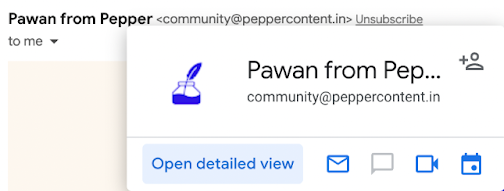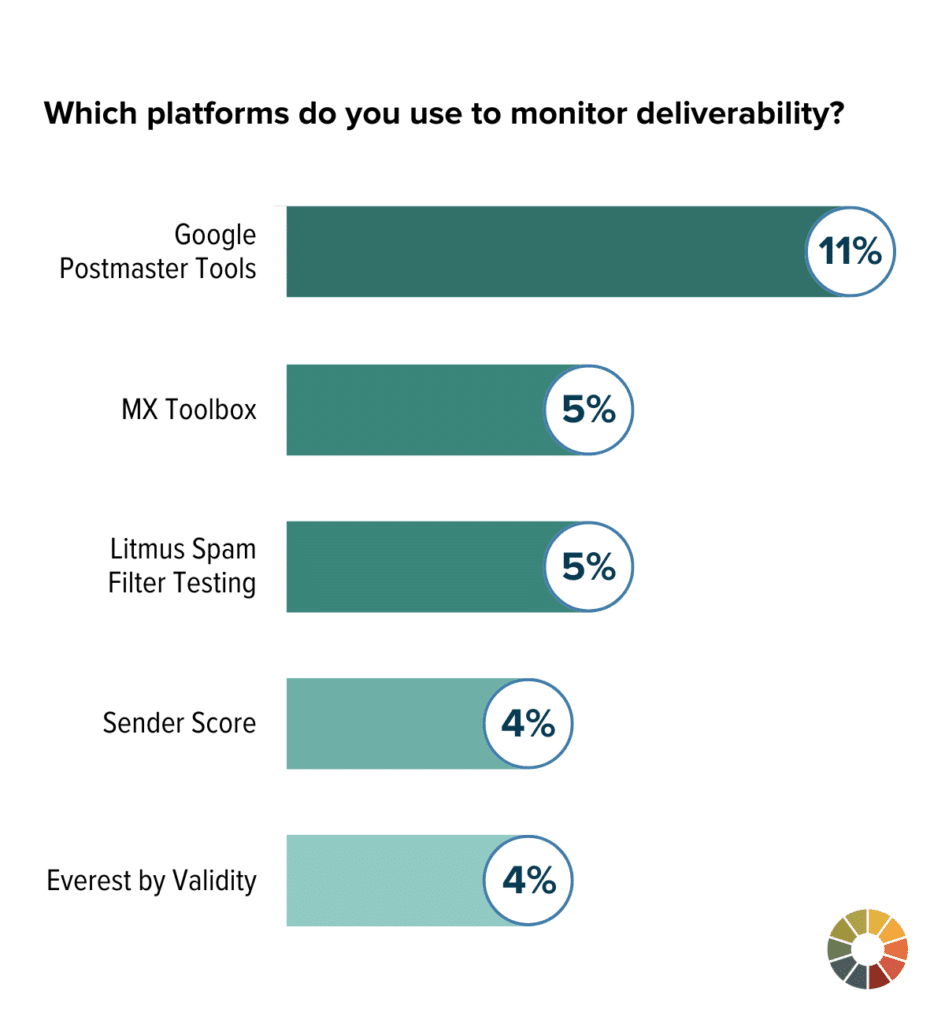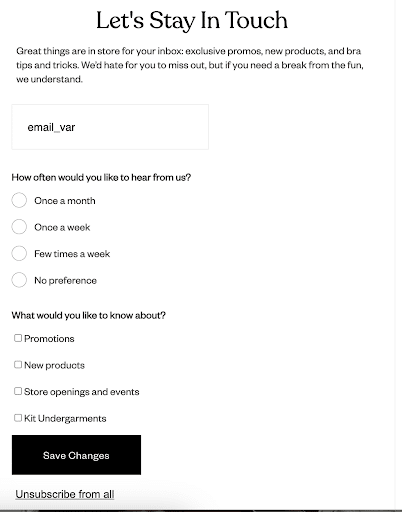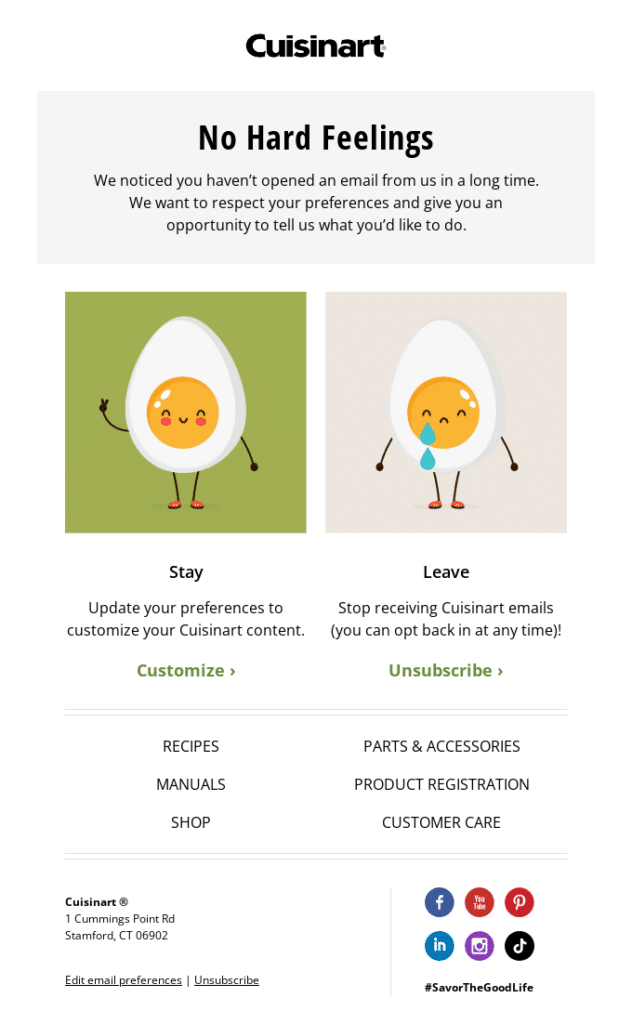Probably the most irritating a part of electronic mail advertising? Placing weeks of planning and energy into an electronic mail marketing campaign…solely to have it fail to ship. After we requested electronic mail entrepreneurs their key priorities for our annual State of Electronic mail Survey, monitoring their deliverability charges hit the highest 5.
Each time you press ship, your electronic mail goes by means of an impediment course of deliverability checks—meant to maintain spammers and scammers from hurting your subscribers—and generally, your harmless electronic mail advertising campaigns can get caught.
Three major elements affect your total deliverability:
- Infrastructure: Identification and authentication data. These are technical must-dos like DNS, DKIM, and DMARC that your crew (or your electronic mail service supplier (ESP)) wants to finish if you wish to ship emails.
- Content material: What your message incorporates and the way your subscribers reply. If somebody marks you as spam, you’re going to be within the spam folder.
- Fame: The receiver’s ranking of your sending area and IP addresses, form of like a credit score rating, however for electronic mail geeks.
When you’re struggling to land emails within the inbox, and also you’ve already dotted your i’s and crossed your t’s with infrastructure, it’s time to dive into the nebulous black field of electronic mail sender popularity. On this weblog publish, we’ll cowl:
- What’s electronic mail sender popularity?
- What’s area popularity and sender rating?
- Find out how to examine your electronic mail sender popularity
- Why has your electronic mail popularity gone down?
- Find out how to get better from a poor sender popularity
- Prime finest practices for electronic mail sender popularity
What’s electronic mail sender popularity?
Your electronic mail sender popularity is a rating or measure that Web Service Suppliers (ISPs) assign to a corporation sending emails. Your electronic mail deliverability is a results of your electronic mail popularity. The higher your popularity, the extra probably you’ll have increased electronic mail deliverability. ISPs have a look at a number of various factors when figuring out your popularity:
1. Your sender conduct
ISPs are carefully watching the amount of emails you ship and the way constant you might be. Sudden spikes could make it appear like you’re participating in spammy conduct.
“A pointy improve in quantity, the place you often ship 1,000 emails in a single week, after which one week you ship 15,000 goes to make a variety of ISPs look twice,”
It’s okay to ship plenty of emails (yay for giant electronic mail lists!) however don’t overload your subscribers. Consistency is essential. Persist with a gentle cadence, and keep away from large jumps in quantity.
2. Your subscriber conduct
Your popularity hinges on how your subscribers work together together with your emails. Are they opening them, clicking by means of, replying, or forwarding? Or are they marking them as spam and unsubscribing? ISPs search for constructive engagement alerts.
ISPs frequently have a look at:
The extra your subscribers interact together with your content material, the higher your popularity. In the event that they’re not participating, it’s time to rethink your method—as a result of engagement is a vote of confidence in your emails.
3. Your electronic mail checklist hygiene
Holding a clear electronic mail checklist is essential for sustaining a superb popularity. Hitting spam traps—these sneaky addresses designed to catch spammers—or being listed on a blocklist can critically harm your standing.
Different elements ISPs consider embrace:
- In case your group hit any ISP spam traps or is on any blocklists
- Electronic mail bounces
Often scrubbing your lists for inactive subscribers and onerous bounces will allow you to keep away from these pitfalls. Good checklist hygiene reveals ISPs that you simply’re sending to a wholesome, engaged viewers.
4. Your electronic mail authentication
ISPs need to see that you simply’re taking part in by the foundations. Organising correct electronic mail authentication protocols like SPF, DKIM, and DMARC helps show your legitimacy. Consider these because the “ID checks” in your emails—displaying that you’re who you say you might be and constructing belief with each ISPs and your viewers.
Observe: All ISPs will weigh these elements in a different way.
What’s area popularity and sender rating?
Every electronic mail sender has a sending area. It’s the textual content that follows ‘@’.
For instance, right here the sending area, or area title, is ‘peppercontent.in’.

Your sending popularity is determined by the area and IP handle you’re sending emails from—plus extra elements:
“When launched to the idea, individuals are likely to assume that “sender popularity” is an alpha or numeric rating assigned by the Web, simply calculated and cataloged. Each a lot easier and rather more sophisticated, sender popularity is the email-specific final result of what individuals actually take into consideration your model. Your popularity is predicated by yourself behaviors and customers’ responses to them, which in flip affect the place mail finally ends up subsequent time, whether or not that’s in your subscribers’ inboxes, spam folders, or blocked altogether. If individuals sincerely such as you, their conduct will present it and also you’ll be rewarded with inbox placement. But when recipients simply aren’t that into you, your messages shall be relegated as spam or rejected, even in the event you’re not breaking the regulation or sending what you take into account to be spam. Fame isn’t a grade, it’s an ongoing evaluation of your model’s respect in your mutual prospects.”
Your IP popularity issues. When you’re on a devoted IP handle, you’ll have a a lot clearer picture of your email-sending popularity. However in the event you’re on a shared IP handle, your electronic mail sending popularity could also be impacted by others in your shared IP.
Find out how to examine your electronic mail sender rating
Electronic mail deliverability could make or break your electronic mail advertising technique—it’s that essential. But, 22% of electronic mail geeks who took our survey admitted they don’t measure their deliverability (or aren’t certain in the event that they do). Stunning, proper? The excellent news is that checking your sender rating doesn’t should be sophisticated or costly. There are free instruments on the market, like Google Postmaster Instruments, that make it simple to see how your emails are performing and the place you stand.

(Pssst, you can even get a full suite of deliverability instruments, together with monitoring your sender popularity, with Litmus Spam Testing.)
Why has your electronic mail popularity gone down?
Your electronic mail popularity is formed by a number of key elements: your sender conduct, your subscriber conduct, your checklist hygiene, and your electronic mail authentication. When you’re seeing a dip in your popularity rating—or noticing poor efficiency in your electronic mail campaigns—it’s price taking a more in-depth have a look at these areas:
Sender conduct
Typically, fixing your electronic mail popularity could be so simple as altering your personal conduct. When you’re seeing a drop in your sender rating, ask your self:
- Is the amount of emails too excessive or inconsistent?
- Am I sending emails to individuals who have unsubscribed or present no engagement?
- What sort of automations do I’ve arrange, and are they mandatory?
- Have I landed on a blacklist or blocklist?
Subscriber conduct
Your sender popularity is immediately tied to how your subscribers reply to your emails. If engagement is low, it’s time to dig into your metrics:
- Am I working any automated campaigns that persistently get low open or no clicks?
- What are my total open and click on charges for my electronic mail campaigns?
- What number of unsubscribes have been reported lately?
- Am I offering a transparent and straightforward method for individuals to unsubscribe?
- What number of spam complaints am I getting?
- Are my emails too lengthy and getting lower off by electronic mail purchasers?
Electronic mail checklist hygiene
In case your subscribers aren’t responding to your emails the best way you hope, then it could be a mismatch between who’s in your checklist and the sorts of emails you ship. Conduct an electronic mail checklist audit and ask your self:
- The place did I get these subscribers, and did I’ve their express permission to electronic mail them? (And keep in mind—by no means purchase an electronic mail checklist—that’s a surefire technique to spoil your sender popularity.)
- What’s my bounce price for onerous bounces and comfortable bounces?
- Am I sending emails to spam traps?
Electronic mail authentication
With out correct electronic mail authentication, ISPs may not belief your emails. Be sure to have SPF, DKIM, and DMARC arrange accurately. These protocols show you might be who you say you might be, which builds belief with ISPs and helps shield your popularity.
Diagnosing what’s inflicting a dip in your sender popularity helps you handle the issue head-on and get again on monitor.
Spam folder no-more
Implement finest practices to maintain your emails out of the spam folder. Enhance your deliverability charges and attain extra inboxes.
Find out how to get better from a poor sender popularity
Belief us, poor sender popularity can occur to anybody. In June 2022, we skilled a difficulty with our electronic mail popularity as we observed our inbox placement had gone from 98-99% to lower than 90%.
Uh-oh.
If that is taking place to you proper now, right here’s what to do:
Step 1: Determine the problematic ISP
In our case, it was Gmail.
The important thing right here is to determine which ISP you’re having problem with and ship solely to your most engaged audiences for that ISP. Whereas this may drastically convey down the variety of individuals you’re reaching together with your emails, it should enhance your engagement charges and guarantee inbox placement.
This step will point out to your mailbox supplier that your emails should not spam, and your readers are participating with them.
We used Litmus Electronic mail Analytics to determine subscribers who use Gmail to open our emails and segmented that viewers into those that engaged within the final 10/30/45/60/90 days. We then suppressed Gmail subscribers who hadn’t opened within the final 10 days. Then, we slowly elevated quantity, week by week, and tracked engagement.
Step 2: Determine dangerous electronic mail automations and switch these off
Campaigns resembling win-back electronic mail campaigns are dangerous. In spite of everything, they’re reaching out to an already disinterested viewers. The probabilities of them opening your emails and fascinating together with your content material are low.
Electronic mail automations your subscribers and prospects may not interact with embrace:
Despite the fact that these electronic mail flows can generally work to revive disengaged prospects and subscribers, they’ve the next chance of going unopened and never clicked on than transactional or different emails within the promotions tab in Gmail. If these marketing campaign emails don’t result in engagement, it should additional hurt your electronic mail popularity. Flip these campaigns off to enhance your engagement charges in the event you’re having a popularity disaster.
Step 3: Contact your Postmasters
When you’ve taken steps to treatment your deliverability points, however it’s nonetheless not working, you can even attain out to your ISP postmasters. A postmaster is the administrator of an electronic mail service. They take care of spam emails and sender popularity.
When you’ve recognized your problematic ISP, ship them a report utilizing these kinds:
Gmail’s postmasters could not reply. So, till you see an enchancment in your inbox placement, maintain notifying Gmail of your points by means of their postmaster contact kind—advisably each week.
Outlook and Yahoo Mail, then again, will probably reply to you by way of electronic mail inside three to 4 days. Their response will point out whether or not they’ve discovered points together with your electronic mail area and are engaged on a repair, or that they haven’t discovered any points.
Step 4: Begin rising ship quantity when engagement charges improve
When you see an uptick in engagement charges—and solely then—you can begin sending emails to extra individuals once more.
For instance, in the event you had been beforehand solely sending your campaigns to individuals who had opened your emails within the final 15 days, now you can increase the bar to 30 days. Monitor the brand new outcomes after which rinse and repeat till you hit your typical, full sending quantity.
For acquisition-related campaigns (the place you’re contacting new/unengaged subscribers), having a secondary devoted IP handle can shield your main IP handle (used for campaigns that drive enterprise targets and must have good inbox placement charges). At Litmus, we’ve onboarded a secondary IP handle and a secondary sending subdomain for acquisition packages, cart abandon packages, and re-engagement nurtures.
Electronic mail sender rating finest practices
Hopefully, you’ll by no means should take care of a dip in popularity like we did. (Phew, we’re so glad that’s over.) Within the meantime, although, there are proactive steps you possibly can take in your electronic mail advertising program:
Take into consideration your ship frequency
Subscribers who see your model title pop up time and again of their inbox could begin to get aggravated—particularly in the event you’re utilizing segmentation or personalization in your emails. The secret is engagement, so give your subscribers the choice to decide on which emails they obtain from you.
This instance from underwear model ThirdLove is a good way not solely to collect extra first-party knowledge out of your subscribers but additionally to just be sure you’re sending the fitting emails to the fitting individuals:

“There’s this expectation that you simply at all times must ship an electronic mail,” says Electronic mail Advertising Supervisor Tracie Pang. “However in the event you’re persevering with to ship emails with out engagement, it’s going to have an effect on your sender popularity. Sending to your checklist a number of days in a row like that would result in a couple of spam grievance as a result of they’re uninterested in listening to from you.”
Make the unsubscribe simple
Equally, make it as simple as attainable to unsubscribe. No extra “hacks” to get round authorized necessities. Don’t concern the unsubscribe electronic mail checklist! It’s significantly better to have a barely smaller checklist with increased engagement than a big checklist of people that don’t need to hear from you.
When you don’t make it simple to unsubscribe, you’ll simply see a spike in spam complaints—which can hit your sender popularity onerous. “Some spam complaints may come from not having a straightforward unsubscribe,” says Pang. “You need to have a one-click unsubscribe button to adjust to Gmail and Yahoo, but additionally as a result of it’s one of the best ways to ensure somebody isn’t simply marking you as spam out of frustration.”
Concentrate on minimizing these as an alternative. To adjust to Gmail and Yahoo’s sender necessities (together with deliverability guidelines), for instance, you should keep a spam grievance price of 0.3%, or not more than three spam experiences for each 1,000 messages.
Your deliverability (and your backside line) will thanks.
Clear your electronic mail checklist frequently
Make it a daily to-do to wash out these electronic mail lists. First, you’ll need to filter out frequent typos (like gmial.com or yaho.com) or any electronic mail addresses which have bounced. When you’re seeing a variety of these sorts of emails, then take into account doing double opt-in as an alternative of single opt-in in your electronic mail acquisition. Sure, it provides an additional step for subscribers—however it additionally ensures you’ll by no means add a pretend electronic mail handle to your checklist.
After that, sift by means of your electronic mail checklist primarily based on engagement. Anybody who hasn’t opened an electronic mail in, say, 60 days must be tagged for a re-engagement electronic mail marketing campaign.

Sending a re-engagement marketing campaign is a last-ditch effort to see in the event that they need to keep in your checklist. In the event that they don’t interact with that electronic mail, both, then it’s time to say buh-bye.
Monitor and measure your electronic mail sender popularity with Litmus
The important thing to a profitable electronic mail program is making certain your messages land within the inbox, not the spam folder.
With Litmus, you possibly can scan your emails throughout 20+ spam filters and get real-time motion gadgets to enhance deliverability and keep a robust sender popularity. Plus, our API integrates seamlessly together with your ESP, making it simpler than ever to maintain tabs in your electronic mail efficiency.
Don’t go away your deliverability to likelihood—increase it with Litmus.
Land in inboxes, not spam folders
Scan emails throughout 20+ spam filters, enhance deliverability, and combine seamlessly together with your ESP.

